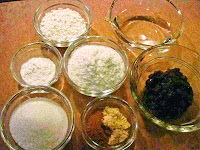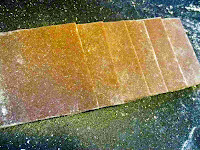<Ingredients>
35 g joshinko regular rice flour
20 g shiratamako sweet rice flour (sweet rice flour solidified into granules)
5 g katakuriko potato starch
40 g sugar
50 cc (3 tbsp + 1 tsp) water
5 g cinnamon powder
4 g kinako roasted soybean powder
50-60 g tsubuan sweet azuki bean paste
1-2 tbsp kinako roasted soybean flour (to sprinkle on pasty board and nama yatsuhashi while rolling out; not in photo)
<Directions>
1.
Start boiling water for steaming.
2.
Put shiratamako sweet rice flour in a heat-resistant mixing bowl, add a small amount (1+ tbsp) of water, and mix well with spatula.
Add remaining water, and mix well.
2.
Add joshinko regular rice four, potato starch and sugar, and mix well until smooth.
3.
When water in steamer boils vigorously, cover the dough bowl with a cloth, place in steamer, cover, and steam for 15 minutes.
4.
Meanwhile, mix cinnamon and kinako powder.
5.
When dough is done steaming, take bowl out of steamer.
Add half of cinnamon + kinako mixture, and mix well with a spoon.
Add remaining cinnamon + kinako mixture, and mix again.
When dough is cool enough to touch, switch to your hands and knead until cinnamon + kinako mixture is well incorporated into dough.
Wet your fingers/hands from time to time if dough is still hot or too sticky.
6.
Roughly form dough into a rectangle, and place on a pastry board lightly sprinkled with kinako.
Roll out to 2mm thick.
7.
Using a paper square as a guide, cut dough into squares.
The cut edges can be sticky, so put some kinako to prevent squares from sticking together.
8.
Place a small amount (1 tsp or so) of tsubuan in the center, and fold in half to form a triangle.
Ready to serve.
<Notes>
- Keeps in a covered container at room temperature for a few days.
- I add katakuriko potato starch to keep the dough soft for a longer time. However, it is optional. If not using katakuriko, increase joshinko or shiratamako by 5g. With katakuriko, the dough tends to be sticky while kneading (mixing cinnamon and kinako soybean powder into the dough), but it is easier to roll out.
- The cinnamon taste intensifies the next day.
- I add kinako soybean powder to the dough to soften the cinnamon taste and aroma. It can be skipped if a clearer cinnamon character is desired.
- Yatsuhashi from shops is much paler; cinnamon oil instead of powder is said to be used.
- There are two types of yatsuhashi: one is steamed with sweet azuki beans as above; the other is baked. The nama in nama yatsuhashi implies soft, unbaked dough. Baked yasuyashi is called katayaki [lit. hard baked] yatsuhashi.
- Sweet azuki bean paste is a typical filling for nama yatsuhashi, which started to be sold in the 1960s. Today, dough flavor variations have expanded to matcha green tea and sesame while filling variations have evolved to include fruit and chocolate.























No comments:
Post a Comment